Following the recent post here about people in China photographed with their possessions, reader Jay D. hipped me to photojournalist Peter Menzel’s 1990 project Material World, which involved photographs of families around the world and their possessions, and became the basis for a book, and a PBS Nova episode. Some images from the Nova page below. This post is part of an occasional series. (THX, Jay!)
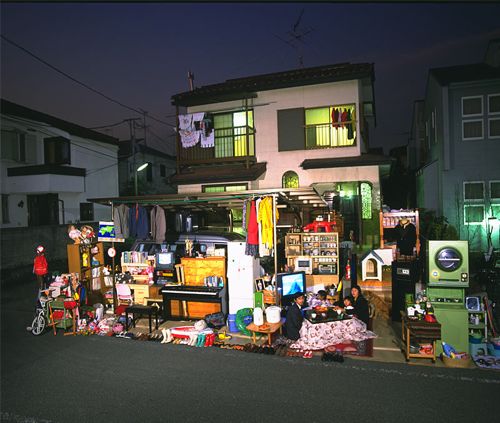
Japan. Photo by Peter Menzel. Click for more.

China. Photo by Peter Menzel. Click for more.

U.S.A. Photo by Peter Menzel. Click for more.
Posted Under:
Artists
This post was written by Rob Walker on May 12, 2010
Comments Off on Pictures of Stuff, cont’d: More (global) people and possessions
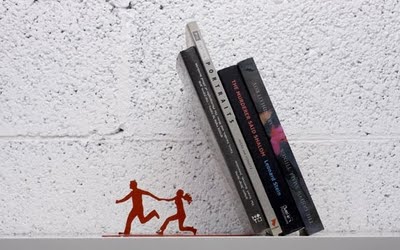
By Art Ori. Click for more.
Via Bookshelf blog. Not so practical, but interesting. Earlier bookends here. Part of a series.
Posted Under:
Products
This post was written by Rob Walker on May 12, 2010
Comments Off on Books, the idea, cont’d: Interesting end
Posted Under:
Non-Daily Linkpile
This post was written by Rob Walker on May 11, 2010
Comments Off on Linkpile
As you may know, Amazon is now compiling and making available to the public information about the “most highlighted” books among Kindle users, and even the “most highlighted” passages. A Dan Brown book, the Bible, and a book I’ve never heard of called The Shack are the top http://pted.org/Propecia.php three most-highlighted works as I type this. In general, the books on that list are religious/spiritual titles; self-help stuff; business-advice books; or some combination of those categories. This is not exactly a surprise, but it’s interesting to see.
It’s more interesting to parse the most highlighted passages, which you can do here. Below the jump, I’ve listed the top ten passages (as of the moment when I’m typing this), without naming the authors or books. I think it’s more fun to read them without that context. And also to wonder about the people who did the highlighting. Perhaps, inspired by David Shields, someone could ativan build an essay, or even a whole book, out of these mostly platitudinous word clusters.
That’s a joke (sort of). But of course this is just the sort of techno-driven development in reading/books that has, in a sense, inspired this entire series. As many have noted:
- books are containers of readable information or stories and so on
- but also: books are display objects (on shelves, or simply being read in public)
Earlier I suggested that if books are going to migrate into digital-only form in time, then perhaps people will need a flat-screen “shelf” that displays the digital spines of whatever we’re reading — or want people to think we’re reading.
I’m not completely serious about this stuff … but I’m not completely kidding. What could be done with the information that Amazon is gathering from Kindle users? Possibly your favorite highlighted passages could be a screensaver or something? Or run a as a kind of news ticker beneath the digital renderings of bookspines or the virtual shelving unit described above?
Anyway. Here are those top highlighted passages. See what you make of them: Read more

By Oscar Nuñez, click for more
“Not available for Kindle,” is the headline on a MetaFilter item: “There may be more ways to shelve your books than there are books.” It links to four posts on a site called WebUrbanist, each of which rounds up multiple examples of unusual (innovative? weird?) bookshelves or bookshelf variations or comments on the form of the form of the bookshelf.
Some examples are things that have come up in this series before, like the “curated” bookshelf, and the work of Jim Rosenau — though here’s one more image of Rosenau’s impressive work anyway:
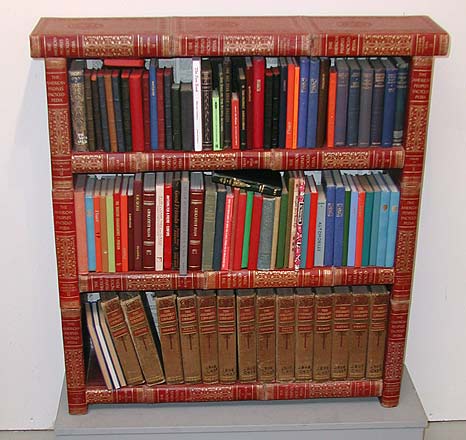
Bookshelf made of books; By Jim Rosenau; click for more.
I’ve had the passing thought in my ongoing excavation of the previously mentioned Bookshelf blog (actually the source of the top image on this post; it just seemed appropriate) that physical books are going to survive for a very long time, if for no other reason than to supply the demand for something to put on the rather astonishing number shelf solutions designers and artists seem to be dreaming up nonstop.
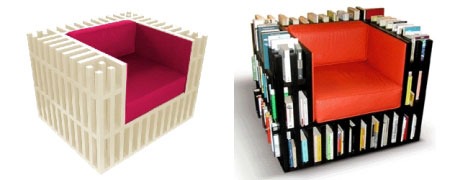
“Bibliochaise” on WebUrbanist, click for more.
DIY types, too:
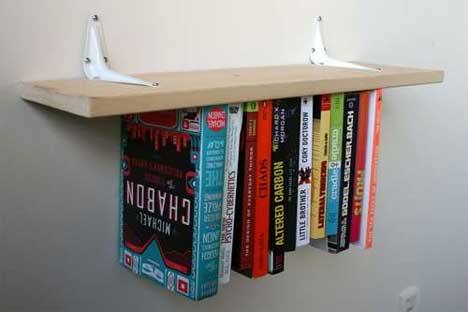
Via WebUrbanist; click for more.
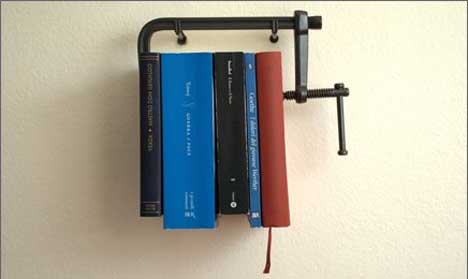
Via WebUrbanist, click for more
On the other hand, the second comment to that MeFi post counters: “Only point is, no real book lover would spend so much money on something that has so little to do with reading. Most of the cases linked are for people who buy their books by the colour of the covers.” [UPDATE: The picture below, not attributed on WebUrbanist, is by Flickr user chotda, and can be viewed (with annotations) here. (Thx Cybele).]
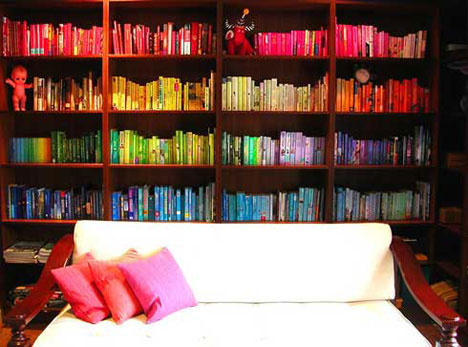
Via WebUrbanist
Ah, but on the third hand, with books and shelves on the brain I couldn’t help but be amused by this comment in a Mindhacks link roundup: “Why Humans Have Sex. A podcast for the The New York Academy of Sciences oddly fails to mention wanting to check out people’s bookshelves. Maybe that’s just me?”

Via Web Urbanist; click for more.

By Huang Qingjun, click for more
The inexhaustible Junk Culture:
Huang Qingjun and Ma Hongjie … project ‘Family Stuff’ [aims] to portray rural Chinese families and their possessions …. A series of 20 images has been compiled that were exhibited at the 798 Photo Gallery in Beijing in 2007… . In 2011 the project is scheduled to end with a total of 50 pictures and a book.
This post is part of an occasional
series.
Posted Under:
Artists,
World News
This post was written by Rob Walker on May 10, 2010
Comments Off on Pictures of Stuff, cont’d: Chinese families and their possessions
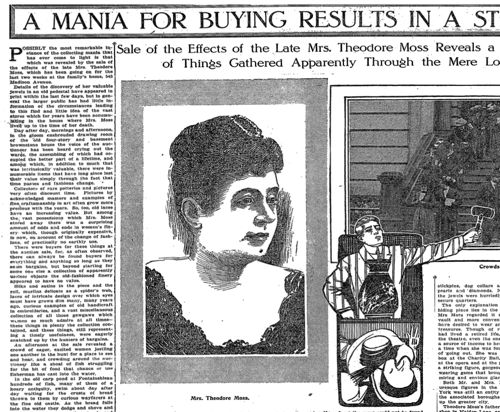
Click to get the whole 1910 article as a PDF from SundayMagazine.org
“A Mania For Buying,” announced the headline in the May 1, 1910 issue of The New York Times Magazine. The article concerns the liquidation of the “effects” of one Mrs. Theodore Moss: “A Remarkable Assortment of Things Gathered Apparently Through The Mere Love of Shopping.” While the piece hedges here and there in a not-particularly well-articulated attempt to distinguish between positive and negative aspects of material want, those words from the subhead give away the unnamed writer’s real attitude with its moralizing “mere.”
I read this article courtesy of the web site SundayMagazine.org, which makes available in PDF form “the most interesting articles” from the Times Magazine from 100 years ago, every week. I’m a great believer in reading this sort of thing: Actual contemporary views of the past, as opposed to the selectively filtered versions fed to us current pundits and gurus who twist history to fit whatever theory they happen to peddling about “today’s consumer.” (And obviously, given my day job, this particular source of special interest.) So here, what we have, is a 1910 assessment of collecting, hoarding, materialism. What does it tell us?
For two weeks, we learn, the spoils of Mrs. Moss’s “collecting mania” have been auctioned off, day after day, from her former home at 543 Madison Ave. Her name was Octavia A. Husted when she married Mr. Moss; she came from “old Revolutionary stock.” As Mr. Moss’s fortunes rose, the article allows, both he and his wife developed luxurious tastes. But back then, at least, Mrs. Moss’s “fondness for fine fabrics” and the like was no mania. Rather, it simply led her “collect” a variety of stuff — “not for hoarding, but merely because she liked looking and such things and liked to have them in her possession.” Thus she owned some real valuables; there is a long (and pretty unlikely) aside about jewels discovered by accident by someone who knocked over a pedestal that turned out to be stuffed with jewelry and gems.
But somewhere along the way – I guess after Mr. Moss died, although the piece isn’t really clear on that – something seems to have changed. By the time of her own death, Mrs. Moss had filled “at least” 10 of her four-story home’s 17 rooms with objects of all sorts. (Supposedly, in another hard-to-believe detail, she carried the keys to these rooms about … and no one else could enter.) Conceding the presence of worthwhile items, the article swiftly shifts to a judgmental, and condescending tone: “there were innumerable items that have long since lost their value simply through the fact that time passes and fashions change.” Let that be a lesson to you, readers! Time passes, fashions change, it is a simple fact that much of what the market offers will lose value.
This vaguely self-helpy tut-tutting continues:
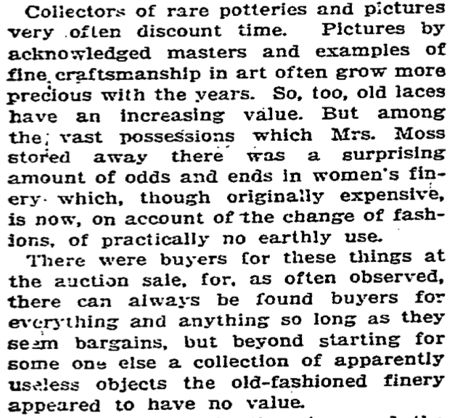
No value, y’all.
Note, if you will, the heavy marketplace bias in these judgments. We cannot say what Mrs. Moss’s things meant to her. We can only say what they “mean” to the market, which renders its verdict in the form of a sales price, period.
Along the way, we’re given rather blatant cues to draw a line around “shopping,” particularly of the enthusiastic sort, as a foolish and distinctly feminine pursuit: Those attending the auction of the Moss pile seem to be “excited women jostling one another,” as the writer puts it, driving home his (one assumes!) point of view by drawing a comparison to fish mindlessly swarming crusts flung into their line of sight.
You may read the full article to learn how the Mos fortune was acquired, and how great chunks of it were deployed, all in rather repetitive detail. But the piece’s guiding “idea,” as we say in the 21st Century magazine game, concerns the relation between people and things. Conveniently, on this score, Mrs. Moss’s effects include a “well-thumbed” book on the subject of collecting, which our correspondent seems at least to have skimmed. Evidently this volume was pro-“collecting.” Read more
 JUST PRICELESS:
JUST PRICELESS:
Assessing the value of an art object that sells itself.
…. Even if [he] won the object, created by a young artist named Caleb Larsen, his ownership would be tentative: the technical innards of “A Tool to Deceive and Slaughter” carried a program that would relist the thing on eBay every week, forever.
Read the column in the May 9, 2010, New York Times Magazine, or here.
Discuss, make fun of, or praise this column to the skies at the Consumed Facebook page.
Posted Under:
Artists,
Consumed,
Things/Thinking
This post was written by Rob Walker on May 9, 2010
Comments Off on In The New York Times Magazine: A thing that sells itself
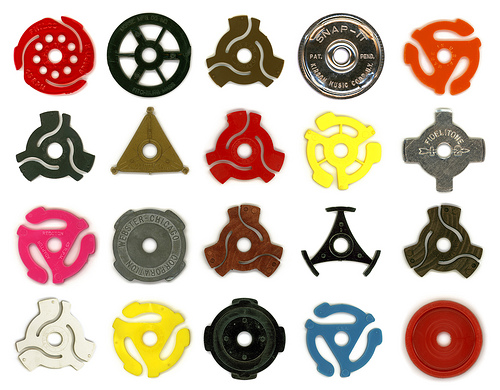
By Glen Mullaly. Click for more.
Part of an occasional series.
Posted Under:
Just Looking
This post was written by Rob Walker on May 8, 2010
Comments Off on Pictures of Stuff, Cont’d: 45 Adapters
Via Not A Real Thing: Below are images made by Flickr user Max Capacity. I gather this person gets these digital cityscape sklyines from video games and adjusts them into the works you see below. Pretty great, if you ask me. (I know you didn’t ask me.) Click any image to go the Max Capacity Flickr image.

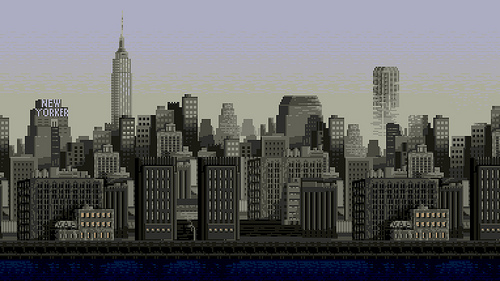

Posted Under:
Just Looking
This post was written by Rob Walker on May 8, 2010
Comments Off on Weekend visuals
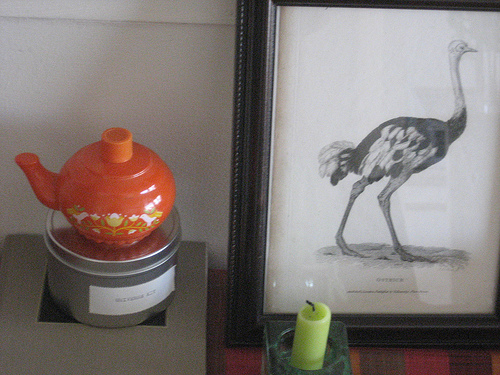
A v3 Significant Object in its new home
This morning, Significant Objects (the side project I work on with co-founder Joshua Glenn), wrapped up its third volume. With our final v3 auction concluded, we converted $58.28 worth of thrift-shop bric-a-brac, paired with 50 stories by our amazing contributing writers, into a whopping $1,748.82 — which will now be donated to Girls Write Now.
GWN is a nonprofit that “provides guidance, support, and opportunities for New York City’s underserved or at-risk high school girls, enabling them to develop their creative, independent voices, explore careers in professional writing, and learn how to make healthy choices in school, career, and life.” While it’ s obviously too late to help GWN by buying a Significant Object, you can still support this fine organization by purchasing one of the limited-edition yet highly affordable Significant Objects v3 prints by Kate Bingaman-Burt, from 20X200.
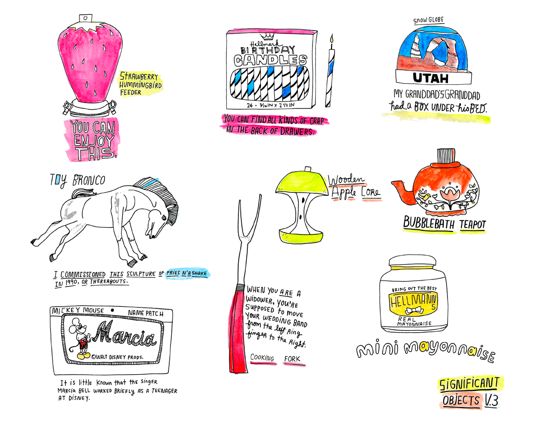
One of Kate Bingaman-Burt S.O. v3 creations
Stay tuned to Significant Objects for news of that project’s future.
Posted Under:
Things/Thinking
This post was written by Rob Walker on May 7, 2010
Comments Off on Significant Objects v3 concludes; $1,748.82 raised for Girls Write Now
- ‘One Hour Photo’: Exhibition of images that will “be disposed of” after one hour. “By forcing a shelf life on an art object [the show] takes aim at a Facebooking, Twittering world of mediated experience. We’re so busy reading about other people’s experiences that we have fewer and fewer experiences of our own. In “One Hour Photo,” you either see the picture or you don’t.”
- The Limitations Of Today’s Soundproofing Magic & The Perennial Noise of Marketing: A note on trying to buy quietness.
- Disabled Alt poses in risque photos for anti-American Apparel themed art project: Carles weighs in at Hipster Runoff.
- The Year of the Drone: “Our study shows that the 129 reported drone strikes in northwest Pakistan, including 34 in 2010, from 2004 to the present have killed approximately between 898 and 1,336 individuals, of whom around 609 to 958 were described as militants in reliable press accounts. Thus, the true civilian fatality rate since 2004 according to our analysis is approximately 30 percent.”
- Twitter: No matter what Hollywood thinks, it’s totally uncool for kids: “I don’t know one high schooler that uses Twitter,” says teen. Friend adds: “It’s something for adults who feel like it makes them hip or something. Meanwhile: Twitter archive at Library of Congress could help redefine history’s scope.
- When Fans Become Advertisers: Interview with Smallville superfan about efforts to fund, produce, and air a “professionally filmed” commercial on behalf of the show.
- Webism: “From the first, and in no small part because of its fervent supporters, it has felt less like a technology and more like a social movement—like communism, like feminism, like rock and roll.” Some priceless stuff in this monumental essay. Also some junk, but it’s worth wading through that. (Bonus: A very rare CORRECT usage of the word eponymous!)
- Surviving the Age of Humiliation: “All of us now live under the threat of easy and instant humiliation. It’s no longer just celebrities and business executives who need to think about aggressive reputation-protection and face-saving techniques. ‘Google yourself at least once a week,” advises Richard Levick, who heads a strategic communications firm in Washington, D.C. ‘You need to track what’s being said about you’ on blogs, message boards and social-networking websites.” While there’s a bit of a cranky worrywort tone to this piece, I think in places it’s getting at something legitimate.
- Nothing can stop the spendthrift American: “Spending rose 0.6 percent, but income rose only 0.3 percent. For the third straight month consumer spending rose faster than income. Not uncoincidentally, the personal savings rate has declined to the lowest point in 18 months.”
- A special report on television: The lazy medium: “There turns out to be an enormous gap between how people say they watch television and how they actually do. This gap contains clues to why television is so successful, and why so many attempts to transform it through technology have failed.” I look forward to the marketing guru class continuing to ignore this sort of information, and sticking with meaningless poll results to make their arguments.
- How to Design Like You Give a Damn in 5 Easy Steps: The funniest headline I’ve seen in a while. Here’s a thought: If you need a “5 easy steps” primer on giving a damn, you don’t actually give a damn.
These links compiled via delicious, and repurposed here with plug-in Postalicious. Not enough stuff? Not the stuff you wanted? Try visiting unconsumption.tumblr.com, murketing.tumblr.com, and/or the Consumed Facebook page.
Posted Under:
Non-Daily Linkpile
This post was written by Rob Walker on May 7, 2010
Comments Off on Linkpile
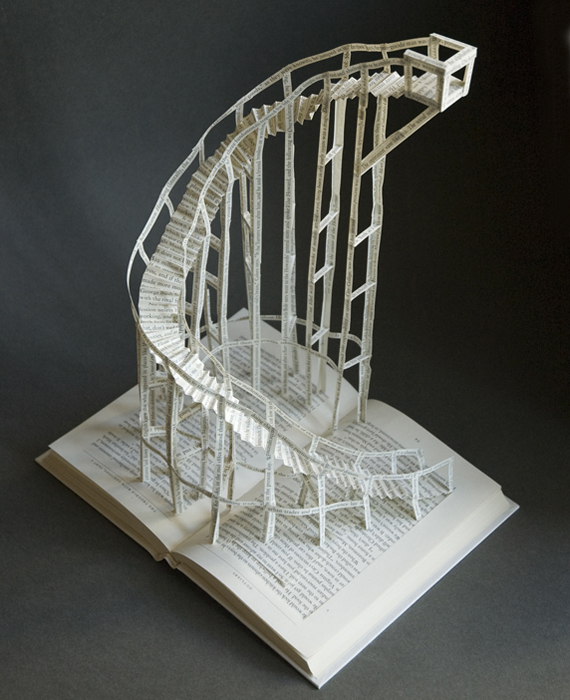
By Stephen Doyle. Click for more.
Junk Culture strikes again with this post pointing to a photo-filled interview with Stephen Doyle. Excerpt:
Q Why work with paper and books?
Books are where ideas come from. The book is such a great form. Before doing these works, I was making concrete casts of books. What interested me was, if you take all the information out, does the form still have any power?
Somewhere along the line I started wondering, well, what does happen when you take the ideas out? So, I started taking out the binding and the pages and setting the words free. And I’ve been working from there.
This post is part of a series.
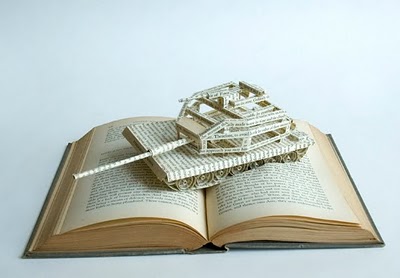
By Stephen Doyle. Click for more.
Posted Under:
Artists
This post was written by Rob Walker on May 7, 2010
Comments Off on Books, the idea: Paper sculpture
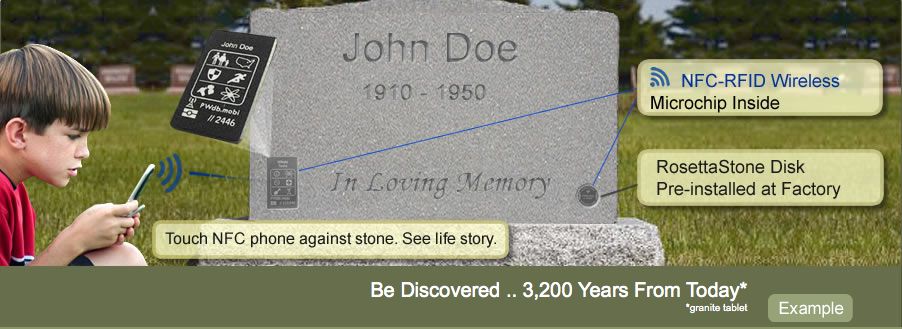
Click for more information.
Here is RosettaStone, a product of Objecs LLC. I read about it in Obit Magazine. As I understand it, it’s a piece of granite inlaid with symbols of your choosing, and it contains digitally accessible information about you. It’s meant to be embedded in your tombstone. But you can buy it now, and start crafting the message you want to leave behind, about you, which will be available to people with the right cellphones, or whatever, for upwards of 3,000 years. You can “be discovered” by citizens of the future, as the company’s site says. It also says: “Be more than a name and date for future generations.”
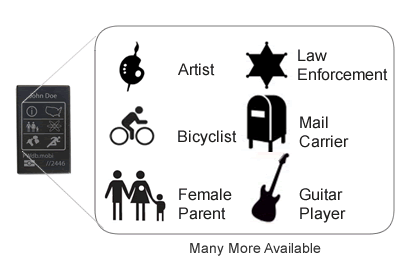
Some choices. Click for more information.
Obit Mag interviewed a man who bought one:
Hill has been updating and frequently rewriting the text he wants to accompany his RosettaStone entries frequently.
“If a truck hits me tomorrow, I’ve got some words that will last forever and that’s real,” he said. “It’s hard to write at first. You’re thinking, ‘Wow. These are my last words.’”
Wow, indeed. Also, “for a limited time,” you can get a “tablet case,” so you can carry this around with you, I suppose, until you die.
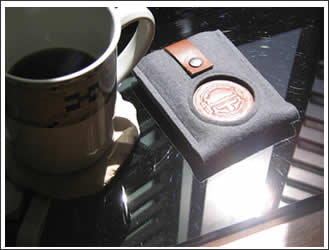
“Limited time” offer. Click for more.
Obit Mag says “fewer than 100” have been sold.
The scenario described in this post by Douglas McLennan of the very useful ArtsJournal site, is pretty much exactly what happened to this site last February — and kept Murketing.com inaccessible to most readers for more than a week. I highly recommend reading McLennan’s account of his experience of being labeled an “attack page” if you are the proprietor of your own site. I agree with basically all of McLennan’s points, most notably this:
In my case (and probably for many others), the Google system for getting unblocked from the rest of the web sucks. Google offers low information about your status once you’ve been blocked and no information after you’ve done what they’ve suggested. For a news site that depends on constant updating, three days being blocked from most of the web is devastating.
Obviously the consequences for a site like mine aren’t that big a deal — I’m just some guy. But for a site like McLennan’s it really can be a serious problem. I’m glad his specific issue finally got resolved, and I hope the broader issue gets some attention.
Posted Under:
Backlashing
This post was written by Rob Walker on May 6, 2010
Comments Off on ArtsJournal describes being hobbled by Google




 "
"














 JUST PRICELESS:
JUST PRICELESS:






















 Kim Fellner's book
Kim Fellner's book  A
A